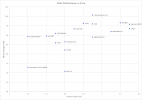I have an RSL 10s mk2 sitting here right now. Within the next day or two I will do my in-room objective measurements and report back, like I've mentioned before. At the very least, it'll be a good exercise in a "value" sub vs. a "luxury" sub (the ELAC ds1000, which I also currently have in-room). I don't think the RSL, or the mk2 anyway, has really been dinged for port noise, and at least on this new one I have the port has rounded edges etc. ... I don't anticipate port noise issues, at least at the levels I listen ... but again, soon we shall see and hear in my particular real world.
(I save my "really loud" experiences for rock concerts, and I bring Experience earplugs w me too for if I feel the concert sound is getting dangerous... good recommendation, btw, those Experience earplugs; they're designed for concerts and reduce overall decibel levels but still allow most of the frequencies to pass through, with perhaps a little muting of the upper freqs, and are mechanically adjustable for volume level. They come with a little plastic round case to slip in pocket.)
need sub-bass more for what? depends on what one is looking for, one's goals... perhaps I'm not enthusiastic about sending earthquake-like shock waves to the neighbors, nor to impose them on other members of my household, for that matter. I don't care at all about "Edge of Tomorrow" ... blech, even, to that one.
I do like a well-integrated quality sub, don't get me wrong... but on the other hand, I ran with Epi 100 speakers (8" woofer, roll off at about 42) for years and rarely if ever thought the bass was lacking and in fact it was very high quality, tickled the inner ear. Now, I have Q Acoustics Concept 50, which are down about 6db at 42, and they sound great as-is, but yes on both the Epi and the Concept 50 having a sub handle 20-40 or 45 is a nice bonus, for sure, for the extra kick and "atmospherics."
But I don't need nor even necessarily want "tremendous output below 20hz"... if there's a little bit down there, OK cool that's fine but certainly not my focus.


